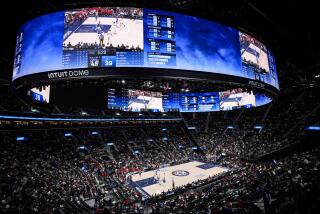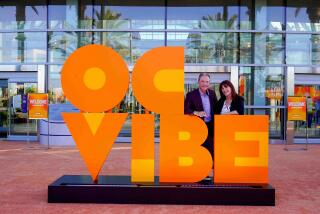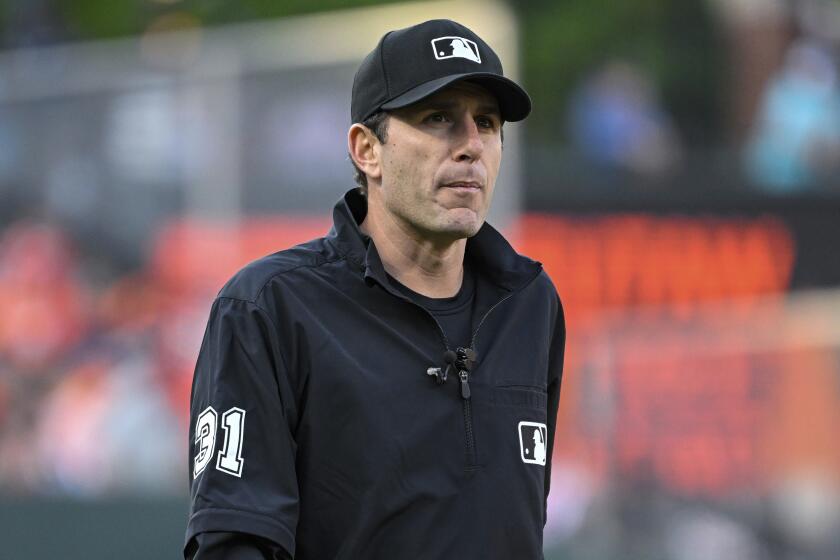Ready to Support the NFL Like Nobody’s Business
- Share via
Bruce Karatz, chairman and chief executive of Westwood-based KB Home, one of the nation’s biggest home builders, predicts “broad corporate support for a professional football team” should the NFL make a return to the Los Angeles area after a 12-year absence.
John Bryson, chairman, president and chief executive of Edison International, the utility with headquarters in Rosemead, says, “We would be supportive.”
John McEntee, president and founder of TEI International, an Anaheim firm that has carved out a lucrative niche providing entertainment for private parties thrown by Fortune 500 companies, can hardly wait should there be a new stadium in that city: “We want to be first in line. We want a good suite.”
NFL owners, meeting Tuesday in Denver, are due to consider a proposal authorizing Commissioner Paul Tagliabue to spend $5 million to $10 million on design and engineering studies at the Coliseum, in Anaheim or perhaps both -- and simultaneously to press Southern California businesses and corporate types for support.
The league, seeking what Tagliabue has called a “surrogate” for taxpayer subsidies perhaps available elsewhere for stadium construction but not in California, has made it a condition of a return to the Los Angeles area that corporate leaders demonstrate fervor for pro football.
As in many aspects of life, but especially with the NFL, the deal is fantastically complex yet remarkably simple: Money talks.
“Especially in this day and age where there is little sentiment for public tax dollars to support a stadium, the enthusiastic support from the business community is a must,” said Ted Phillips, president and chief executive of the Chicago Bears.
An NFL delegation, perhaps including Tagliabue, is due to visit Southern California in early June, expecting to see just how many business people are sincerely eager to plunk down deposits for luxury suites, personal seat licenses, club seats and more.
Gov. Arnold Schwarzenegger, Los Angeles Mayor Antonio Villaraigosa and Anaheim Mayor Curt Pringle have made it plain they expect the league’s demands to be satisfied. Each said he plans to make it a priority.
“I will personally work to get our business community behind bringing a football team back to Southern California,” Schwarzenegger said.
“How involved am I going to be?” Pringle said. “I’m not going to put on an usher’s uniform, but I am going to bring the right people to the table.”
Villaraigosa, saying that he had a “very productive” conversation last week with the commissioner, said he intends to “share with Tagliabue just how strong the business support for an NFL team here in Los Angeles is.”
David Pollock, senior managing director at the Los Angeles office of brokerage house Bear Stearns & Co. Inc., holds Lakers season tickets at Staples Center, six rows from the court, at the free-throw line across from the Lakers’ bench.
When the Raiders played at the Coliseum, he was a season-ticket holder: “Fifty-yard line, unbelievable seats.”
“There will be no problem if a football team comes back to L.A.,” he said. “There will be massive support.”
He added, however, “I don’t want to schlep to Anaheim. I would go to the Coliseum.”
McEntee said of a new stadium, “I want it in the Orange County area. For my own selfish reason. I live in Orange County and I don’t like driving to L.A.”
Edison used to have its name on what is now Angel Stadium. Asked if the company had a site preference, Bryson demurred, saying it “serves a lot of Los Angeles County, all of Orange County, and we have customers spread around the area. We wouldn’t get into the question of whether one or the other location is preferable.”
Asked whether the NFL could expect to be met with enthusiasm across Greater Los Angeles, Bryson didn’t hesitate: “I think that’s fair to say.”
The quest for business support is based in the kind of math that corporate types can readily appreciate: the economics of the modern NFL.
Stadium costs alone for either project are projected at $800 million. The Coliseum would be rebuilt around the peristyle end into a 68,000-seat venue, 80,000 for Super Bowls and USC games. Anaheim would build a stadium and entertainment complex in what are now parking lots around Angel Stadium.
The NFL’s plan is to first select a site. A team and owner would come later; it remains uncertain if the league would pursue expansion or relocate one of the existing 32 teams.
The Anaheim equation includes an unusual wrinkle. The city has given the league a May 31 deadline. After that, officials say, the city would entertain offers from others interested in developing the site -- an intriguing turn of leverage aimed back at the NFL.
“We’re not hammering a ‘for sale’ sign into the parking lot,” Pringle said.
He added: “The point of a community asset is to magnify its value to the community for a long time. We’re not looking for a one-time sale that can bring in a few bucks today.” Rather, the city hopes to plant on the site “an economic generator” that can serve the community and the region.
“At this point,” Pringle said, “I think an NFL facility and all that can be associated with it is a very significant economic generator.” And, he said, “It does at least give a mark with which to compare any new proposal.”
At any rate, the NFL plans to build the stadium, or stadiums, then turn it, or them, over to an owner, or owners.
Ownership would be on the hook for the construction costs; figures such as $40 million annually in debt service have in recent weeks surfaced as talking points. Detailed figures have not yet been made public.
With debt service that high, however, the sale of suites, licenses and seats and, in time, deals for naming rights and other locally generated revenues are essential, particularly with no offsetting tax money available. The Coliseum, for instance, would sell 188 suites, each for hundreds of thousands of dollars or more a year.
Philadelphia Eagles owner Jeffrey Lurie, noting that his team has a waiting list of 60,000 for season tickets, said a rabid fan base, while important, is simply “not what drives the economics that allows you to finance a stadium.”
“What you need,” he said, “is corporate support.... In the past, you’d have franchises getting 100% publicly funded stadiums, and very little acquisition costs with those teams. Now you have franchises selling for more than $800 million.
“You’re talking about how to finance acquisition debt and stadium debt. You’ve got to be creative and be a successful marketer.”
The Eagles, for instance, have an “official bank,” Sovereign Bank. But Lurie said, “There are 14 banks we have as suite holders. Only one can be the official bank of the Eagles. But that doesn’t stop you from having the support and a partnership with each of the other banks.”
Lurie also said, “All of us see the model evolving in Los Angeles as this: We need an economically sound, financially sound operation so that the NFL and Los Angeles will be proud of it.
“It’s not just that we get a team in L.A. We want them to be successful, on and off the field.”
More to Read
Go beyond the scoreboard
Get the latest on L.A.'s teams in the daily Sports Report newsletter.
You may occasionally receive promotional content from the Los Angeles Times.










